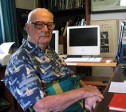Arthur Charles Clarke

Sir Arthur Charles Clarke, CBE, FRAS, Sri Lankabhimanya, (16 December 1917 – 19 March 2008) was a British science fiction author, inventor, and futurist, famous for his short stories and novels, among them 2001: A Space Odyssey (1968), and as a host and commentator in the British television series Mysterious World. For many years, Robert A. Heinlein, Isaac Asimov, and Clarke were known as the "Big Three" of science fiction.
Clarke served in the Royal Air Force as a radar instructor and technician from 1941 to 1946. In 1945, he proposed a satellite communication system—an idea that, in 1963, won him the Franklin Institute Stuart Ballantine Gold Medal. He was the chairman of the British Interplanetary Society from 1947–1950 and again in 1953.
In 1956, Clarke emigrated to Sri Lanka, largely to pursue his interest in scuba diving. That year, he discovered the underwater ruins of the ancient Koneswaram temple in Trincomalee. He lived in Sri Lanka until his death. He was knighted by Queen Elizabeth II in 1998, and was awarded Sri Lanka's highest civil honour, Sri Lankabhimanya, in 2005.
Clarke was born in Minehead, Somerset, England. As a boy, he grew up on a farm enjoying stargazing and reading old American science fiction pulp magazines. After secondary education at Huish Grammar School in Taunton, he joined the Board of Education as a pensions auditor.
During the Second World War he served in the Royal Air Force as a radar specialist and was involved in the early warning radar defence system which contributed to the RAF's success during the Battle of Britain. Clarke spent most of his wartime service working on Ground Controlled Approach (GCA) radar as documented in the semi-autobiographical Glide Path, his only non-science-fiction novel. Although GCA did not see much practical use during the war, it proved vital to the Berlin Airlift of 1948–1949 after several years of development. Clarke initially served in the ranks, and was a corporal instructor on radar at No 9 Radio School, RAF Yatesbury in Wiltshire. He was commissioned as a Pilot Officer (Technical Branch) on 27 May 1943. He was promoted Flying Officer on 27 November 1943. He was appointed chief training instructor at RAF Honiley in Warwickshire and was demobilised with the rank of flight lieutenant. After the war he earned a first-class degree in mathematics and physics at King's College London.
 čeština
čeština Deutsch
Deutsch français
français magyar
magyar polski
polski русский
русский English
English Azərbaycan
Azərbaycan беларуская
беларуская italiano
italiano ქართული
ქართული қазақ
қазақ Nederlands
Nederlands português
português slovenčina
slovenčina español
español 中文
中文







